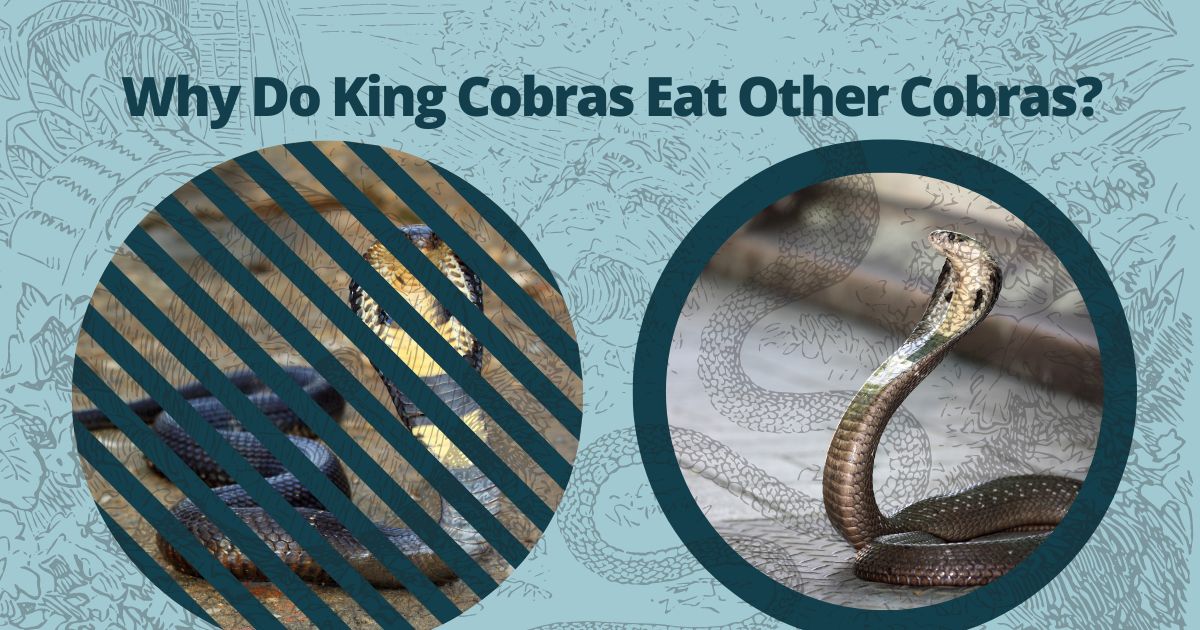
Why Do King Cobras Eat Other Cobras? A Look at Their Feeding Behavior
Why do king cobras eat other cobras?: King cobras, the most important venomous snakes in the world, show off a charming and rather unexpected conduct: cannibalism. This specific dietary desire raises questions about their ecological function and survival techniques.
King cobras basically devour other snakes, inclusive of their personal species, pushed by a combination of things together with food availability, competition, and evolutionary diversifications. Understanding the reasons in the back of this conduct no longer simplest sheds light at the king cobra’s ecological niche
but additionally highlights the complexities of predator-prey relationships inside the wild. In this exploration, we are able to delve into the motivations behind this intriguing component of king cobra behavior.
- What is a Cobra Snake?
- King Cobra
- Diet of the King Cobra
- Unique Behaviors of the King Cobra
- Cannibalism and Its Ecological Significance
- Interactions and Competition
- Venom and Predators
- Reproduction and Development
- Why do king cobras eat other cobras?
- FAQ’S About Why do king cobras eat other cobras?
- Why do King Cobras cannibalize other cobras?
- Is cannibalism common among King Cobras?
- Do King Cobras target specific types of cobras when eating them?
- How does cannibalism affect King Cobra populations?
- What environmental factors increase cannibalism in King Cobras?
- Are there any risks for King Cobras when eating other cobras?
- Can cannibalism affect the behavior of King Cobras?
- Conclusion¬
What is a Cobra Snake?
A cobra snake is a venomous snake known for its unmistakable hood, which it shows when debilitated. There are a few species of cobras, fundamentally found in Africa and Asia, and they are celebrated for their strong poison and capacity to convey a difficult chomp.
Physical Description
Cobras have prolonged bodies, smooth scales, and a trademark hood that they can grow when undermined. They commonly have a three-sided molded head, enormous eyes, and can differ in variety, frequently highlighting shades of brown, dark, or olive, for certain species showing designs. Grown-up cobras can go from around 3 to 10 feet long, contingent upon the species.
Size
Cobras normally range from around 3 to 10 feet long, contingent upon the species. A few bigger animal types, similar to the Lord Cobra, can surpass 18 feet.
Native Habitat
Cobras are principally tracked down in Africa and Asia, occupying various conditions, including woods, prairies, deserts, and agrarian regions. They frequently lean toward areas close to water sources.
Lifespan
Cobras by and large have a life expectancy of 10 to 20 years in the wild, albeit some can live longer in bondage, with legitimate consideration stretching out their lives to around 20 to 30 years.
Sleep Habits
Cobras are principally nighttime, meaning they are generally dynamic around evening time. During the day, they frequently rest in tunnels, hole, or under vegetation to keep away from intensity and hunters. They can likewise be dynamic during the day in cooler environments or during the early morning and late evening.
King Cobra
| Category | Details |
|---|---|
| Scientific Name | Ophiophagus hannah |
| Habitat | Forests, grasslands, and agricultural areas in Asia and parts of Africa |
| Size | Typically 10 to 13 feet; can exceed 18 feet in some cases |
| Diet | Primarily other snakes, including venomous species, small mammals, and lizards |
| Venom Type | Neurotoxic; can cause paralysis and respiratory failure |
| Lifespan | 10 to 20 years in the wild; up to 30 years in captivity |
| Reproduction | Oviparous; females lay 20 to 40 eggs and exhibit maternal care |
| Mating Season | Typically in spring; males engage in combat to establish dominance |
| Behavior | Mostly solitary; territorial, especially during mating season |
| Conservation Status | Least Concern, but facing threats from habitat loss and poaching |
Diet of the King Cobra
The King Cobra: An Overview of Its Diet
The King Cobra essentially nourishes on other snakes, counting both venomous and non-venomous species. It may too expend little mammals, reptiles, and sometimes feathered creatures.
 King Cobras are known for their capacity to overwhelm bigger prey and can devour prey that is up to half their possess length. Their chasing strategy includes snare and speedy strikes, taken after by gulping their prey entirety.
Role of Food Availability in King Cobra Diets
Food accessibility assumes a critical part in the eating routine of Ruler Cobras. At the point when prey populaces, especially different snakes, are plentiful, Lord Cobras can flourish and become bigger. Restricted food sources can prompt expanded contest,
influencing their wellbeing and propagation. Occasional changes and living space adjustments can likewise affect prey accessibility, impacting the scavenging conduct and circulation of Ruler Cobras in their natural surroundings.
Nutritional Value of Consuming Other Cobras
Consuming different cobras furnishes Ruler Cobras with high healthy benefit because of their rich protein content and fundamental fats. This diet is advantageous for development, energy, and conceptive wellbeing.
The admission of venomous species can likewise assist the Lord Cobra with fostering a resilience to poisons, which is worthwhile for endurance in their serious climate.
Do King Cobras Eat Their Babies?
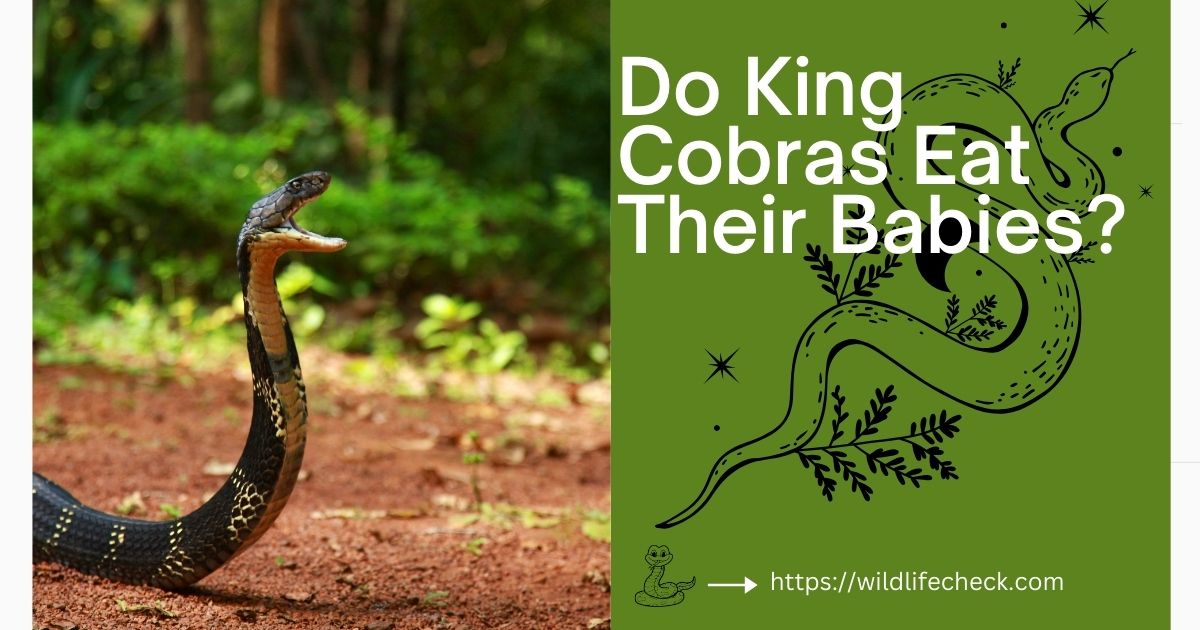
No, King Cobras don’t eat their children. As a matter of fact, female Lord Cobras are known to really focus on their eggs by looping around them to safeguard them during hatching. In the wake of incubating, the youthful are autonomous and should battle for themselves, as the mother doesn’t give further consideration.
Daily Life of a King Cobra
The everyday existence of a Lord Cobra commonly includes hunting, resting, and thermoregulating. They are basically nighttime, becoming dynamic at night to chase after prey, like different snakes. During the day, they frequently look for cover in tunnels or under foliage to stay away from heat.
While hunting, they depend on secrecy and disguise, striking rapidly to catch prey. Subsequent to taking care of, they might rest for a few days to process. Ruler Cobras additionally take part in ways of behaving like luxuriating in the sun to direct their internal heat level and may participate in regional shows or mating ceremonies during the rearing season
Unique Behaviors of the King Cobra
Understanding Cannibalism: A Unique Behavior
Savagery in Lord Cobras, while not normal, can happen in specific situations. It regularly happens when food is scant or during rivalry for assets. Youthful Ruler Cobras might be more helpless against being eaten by bigger people.
This conduct can assist with lessening rivalry and guarantee endurance in conditions where prey accessibility is low. Be that as it may, it’s anything but an essential taking care of conduct and normally emerges from explicit biological tensions.
Why Do King Cobras Eat Other Cobras?
Lord Cobras might eat different cobras in light of multiple factors:
- Healthy benefit: Different cobras are a rich wellspring of protein and fats, giving fundamental supplements to development and energy.
- Contest: Devouring opponent cobras diminishes rivalry for food and region, assisting the Lord Cobra with getting assets.
- Artful Taking care of: Ruler Cobras are crafty hunters. Assuming they experience another cobra, particularly one that is more modest or harmed, they might make the most of the valuable chance to take care of.
- Instinctual Conduct: Barbarianism can be essential for their regular way of behaving, particularly without any other prey.
The Role of Competition in Cobra Diets
Contest assumes a huge part in the weight control plans of cobras. In environments where prey is restricted, cobras might confront serious rivalry from different snakes and hunters. This can impact their taking care of conduct, inciting them to adjust their eating regimen in light of accessibility.
For example, if certain prey, similar to rodents or reptiles, become scant, cobras might go to eating different snakes, including individual cobras, as an elective food source.
Contest additionally influences scavenging systems, with cobras waiting be more astute or forceful in their hunting to get sufficient nourishment for endurance. By and large, rivalry shapes their dietary decisions and hunting ways of behaving.
Survival Strategies: King Cobras and Their Prey
Ruler Cobras utilize a few step by step processes for surviving while hunting and managing their prey:
- Covertness and Disguise: Their tinge assists them with mixing into their environmental elements, considering trap strategies while hunting.
- Trap Hunting: Lord Cobras frequently stand by without complaining for prey to draw near striking distance, limiting energy use.
- Venomous Nibble: They have powerful toxin that immobilizes prey rapidly, permitting them to securely consume snakes that might be venomous themselves.
- Resilience to Toxin: Lord Cobras can foster a resistance to the toxin of different snakes, empowering them to chase a more extensive scope of prey.
- Size Benefit: As quite possibly of the biggest venomous snake, they can overwhelm bigger prey, guaranteeing a fruitful chase.
These procedures upgrade their capacity to track down food and flourish in aggressive conditions.
Mating Season and Its Influence on Cannibalism
Mating season can impact savagery among Ruler Cobras, essentially because of expanded contest for mates. During this time, guys frequently participate in battle with one another to lay out strength and get sufficiently close to females.
In the intensity of contest, bigger or more forceful guys might consume more modest adversaries, especially assuming they are harmed or debilitated from battling.
Furthermore, the pressure of contest can prompt more noteworthy deft taking care of ways of behaving, including savagery, as people might exploit any weak snakes close by. While not an essential way of behaving, this pioneering human flesh consumption can be an endurance strategy during the cutthroat and asset scant mating season.
Cannibalism and Its Ecological Significance
The Science Behind Cannibalism in Snakes
Barbarianism in snakes, including Lord Cobras, is driven by a few organic and natural elements:
- Healthful Advantages: Consuming conspecifics (individuals from similar species) gives a rich wellspring of protein and energy, which can be vital in asset scant conditions.
- Populace Control: Barbarianism can assist with managing snake populaces, decreasing rivalry for food and space. This can be especially significant in territories where prey is restricted.
- Step by step process for surviving: in the midst of stress, for example, during dry spells or environment obliteration, snakes might turn to human flesh consumption for the purpose of endurance. It permits them to productively use accessible assets more.
- Instinctual Conduct: An animal varieties might have an instinctual inclination to consume more modest or more fragile people, particularly youthful or harmed snakes, as a component of their regular way of behaving.
- Territoriality: In cutthroat conditions, bigger snakes might eat more modest ones to declare predominance and diminish contest.
In general, human flesh consumption can be a complicated way of behaving formed by endurance needs, biological tensions, and instinctual drives.
Cobra Populations and the Effects of Cannibalism
Savagery can essentially affect cobra populaces in different ways:
- Populace Guideline: Barbarianism can assist with controlling populace thickness by lessening the quantity of people, which can ease rivalry for assets.
- Hereditary Wellbeing: While it might diminish numbers, savagery can likewise influence hereditary variety. Regular human flesh consumption could prompt a populace with decreased hereditary variety, influencing flexibility to illness and ecological changes.
- Natural selection: Savagery frequently targets more fragile or more modest people, which can prompt a more grounded populace generally by guaranteeing that main the most fit people get by and imitate.
- Asset Distribution: By consuming contenders, barbarianism permits enduring cobras to get to additional assets, which can upgrade development and conceptive accomplishment for those that remain.
- Conduct Changes: High occurrences of savagery can adjust ways of behaving inside populaces, possibly prompting expanded animosity and territoriality as people seek food and mates.
In general, while human flesh consumption might appear to be impeding, it can assume a mind boggling part in forming the elements and strength of cobra populaces.
Myths and Facts About King Cobra Cannibalism
Myths
- Myths: Lord Cobras consistently eat their own young.
- Fact: Lord Cobras don’t commonly eat their young. Females care for their eggs and don’t give further consideration once they hatch.
Fantasy: Barbarianism is the essential food hotspot for Lord Cobras. - Fact: While they may incidentally eat different cobras, their essential eating routine comprises of various snakes and other little creatures.
Legend: Human flesh consumption just happens in the midst of outrageous yearning. - Fact: While craving can set off human flesh consumption, it can likewise happen because of contest or regional questions, in any event, when food is free.
Fact
- Fact: Barbarianism can assist with managing populaces. It can lessen contest for assets, which might help the leftover people.
- Reality: Ruler Cobras might target more fragile or more modest people. Savagery frequently happens among harmed or weak snakes, permitting more grounded people to flourish.
- Reality: Lord Cobras are entrepreneurial feeders. They might consume different snakes, including their own species, whenever the open door emerges, particularly during mating season or seasons of pressure.
Understanding these fantasies and realities can give a more clear image of Lord Cobra conduct and nature.
An Evolutionary Perspective on Snake Cannibalism
According to a transformative viewpoint, snake human flesh consumption can upgrade endurance by managing populace thickness, lessening contest for assets, and permitting more grounded people to flourish. This conduct may likewise add to the hereditary strength of populaces by winnowing more fragile people,
which can prompt more prominent versatility against natural changes and illnesses. Furthermore, pioneering human flesh consumption can amplify asset usage in conditions where food is scant. Generally, it assumes a perplexing part in the transformation and endurance of snake species.
Conclusion: The Significance of Cannibalism in King Cobra Ecology
Barbarianism in Ruler Cobra biology fills in as a critical method for surviving that controls populace elements and decrease rivalry for assets. By going after more fragile people, it can improve the general wellness of the populace, advancing more grounded hereditary qualities.
This conduct additionally permits Lord Cobras to adjust to changing ecological circumstances, guaranteeing their versatility in cutthroat territories. Eventually, barbarianism mirrors the perplexing exchange of endurance, asset allotment, and transformative tensions that shape the nature of these interesting snakes.
Interactions and Competition
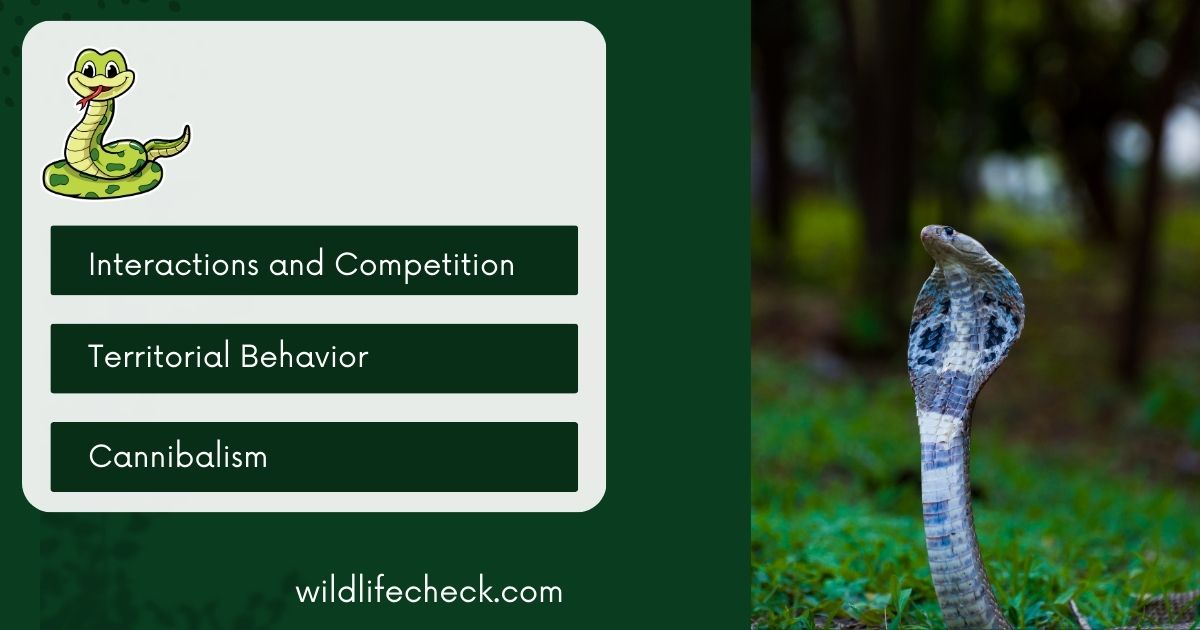
Territorial Behavior and Cannibalism Among King Cobras
Regional conduct in Ruler Cobras can impact savagery, particularly during mating season when guys seek admittance to females. Bigger or prevailing guys might consume more modest adversaries to diminish rivalry for mates and assets.
This forceful territoriality can prompt expanded experiences and astute taking care of, where more vulnerable people are focused on. Hence, the exchange among territoriality and savagery assumes a significant part in their endurance and conceptive achievement.
Environmental Factors Influencing Cobra Interactions
Natural factors altogether impact cobra cooperations, including territory accessibility, prey thickness, and occasional changes. Thick vegetation can give cover to snare hunting yet may likewise prompt expanded rivalry for space and assets. Prey accessibility straightforwardly influences taking care of conduct; shortage can prompt human flesh consumption.
Occasional changes, like temperature and stickiness, can impact mating conduct and regional questions. Also, human exercises, similar to natural surroundings obliteration, can upset these connections, constraining cobras into closer nearness and expanding contest. Generally speaking, these elements shape the elements of cobra populaces and their natural connections.
Behavioral Adaptations of the King Cobra in the Wild
Lord Cobras display a few social transformations that upgrade their endurance in nature:
- Snare Hunting: They frequently lie on pause for prey, utilizing their disguise to mix into their environmental factors and strike rapidly whenever an open door emerges.
- Regional Presentations: During mating season, guys take part in battle and show ways of behaving to lay out predominance and secure mating freedoms.
- Thermoregulation: Lord Cobras loll in the sun to manage their internal heat level, which is pivotal for their metabolic cycles.
- Protection Instruments: When undermined, they can extend their hood, murmur, and strike, utilizing these ways of behaving to stop expected hunters.
- Crafty Taking care of: They adjust their eating routine in light of accessibility, consuming an assortment of prey, including different snakes, which assists them with flourishing in different conditions.
These variations assist Ruler Cobras actually with exploring their natural surroundings and improve their possibilities of endurance.
Venom and Predators
Toxic Venom
Lord Cobra toxin is exceptionally powerful and principally neurotoxic, influencing the sensory system of its prey. It can cause loss of motion and respiratory disappointment, frequently prompting passing in practically no time if untreated. The toxin contains a blend of compounds and proteins that disturb nerve flagging and can likewise influence pulse and coagulating.
Strangely, Ruler Cobras can foster a resistance to the toxin of different snakes, permitting them to chase a more extensive scope of prey, including other venomous species. Regardless of their deadly toxin, Lord Cobras are by and large not forceful except if compromised, frequently liking to keep away from a conflict.
Are King Cobras Immune to Other Snake Venom?
Lord Cobras have a specific degree of resistance to the toxin of different snakes, especially those they generally go after, as different cobras. This resistance permits them to chase and consume venomous snakes without being hurt.
Nonetheless, they are not totally safe; high dosages of toxin or explicit toxin types can in any case be deadly. Their capacity to endure the impacts of other snake toxins is a developmental transformation that upgrades their endurance in cutthroat conditions.
What is the King Cobra’s Biggest Enemy?
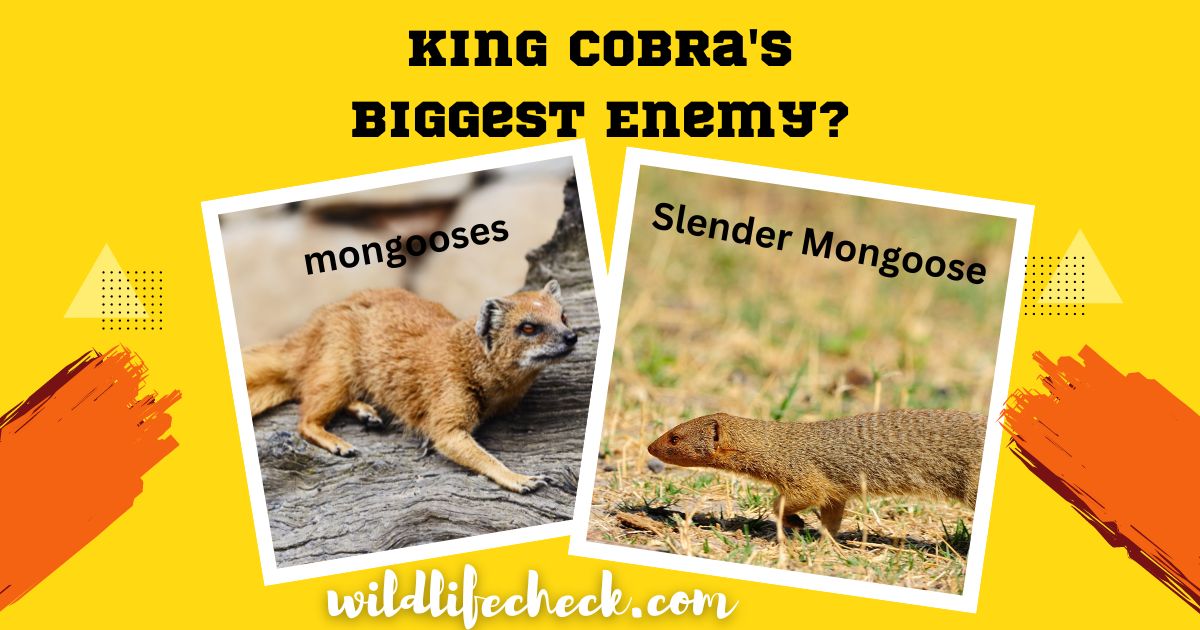
The Lord Cobra’s greatest foes are regularly bigger hunters, including flying predators like falcons and a few huge well evolved creatures, like wild hogs and mongooses. These creatures can represent a danger to adolescent Lord Cobras, while grown-up people are by and large at the highest point of their pecking order.
People likewise represent a huge danger through living space obliteration and hunting, influencing their populaces. Also, rivalry with different snakes can prompt forceful experiences, yet direct predation is more uncommon for grown-up Ruler Cobras.
Which Snake Can Beat a King Cobra?
While the Ruler Cobra is one of the biggest and most venomous snakes, it can in any case confront dangers from other strong snakes. Eminently, the Indian Python can overwhelm a Lord Cobra because of its size and ability to contract.
Moreover, certain huge types of rattlers might safeguard themselves really in the event that they can strike first. Be that as it may, as far as immediate battle, the Lord Cobra for the most part holds a benefit because of its size, speed, and powerful toxin. Most experiences with different snakes will quite often lean toward the Ruler Cobra except if conditions are profoundly good for its adversary.
Which is Deadlier: King Cobra or Black Mamba?
Both the Lord Cobra and the Dark Mamba are very venomous and considered among the deadliest snakes on the planet, yet they have various qualities.
The Lord Cobra has a bigger toxin yield and its neurotoxic toxin can cause loss of motion and respiratory disappointment, possibly prompting demise in no time. It likewise has a more forceful guard conduct.
The Dark Mamba, then again, is profoundly forceful and has one of the quickest striking rates of any snake. Its toxin is likewise neurotoxic, and it can convey various nibbles one after another, prompting fast beginning of side effects.
Concerning sheer lethality, both are destructive, however the Dark Mamba’s blend of speed and hostility, alongside its profoundly intense toxin, frequently prompts a larger number of fatalities. At last, the “destructiveness” can rely upon the particular conditions of an experience.
Can King Cobras Eat Black Mamba?
Indeed, Lord Cobras can eat Dark Mambas. As dominant hunters, Ruler Cobras are known to consume different snakes, including other venomous species like the Dark Mamba. While the Dark Mamba is quick and profoundly venomous,
the Lord Cobra’s size, strength, and capacity to endure other snake toxins empower it to overwhelm and eat them whenever the open door emerges. Nonetheless, such experiences are generally interesting, as the two species will quite often keep away from a showdown whenever the situation allows.
Can a King Cobra Swallow a Human?
While Lord Cobras are equipped for gulping enormous prey, including different snakes, they ordinarily don’t represent a danger to people along these lines. Their most extreme limit with regards to gulping is by and large restricted to creatures that are more modest than their own measurement.
People are excessively enormous for a Ruler Cobra to consume, regardless of whether it were to endeavor to strike or nibble. While Ruler Cobras can convey a possibly deadly chomp, cases of them gulping people are incredibly uncommon and to a great extent a fantasy.
Can King Cobras Love a Human?
Ruler Cobras, as different snakes, don’t have the limit with respect to cherish in the manner people grasp it. Their way of behaving is driven by impulse as opposed to feelings.
While they can become acclimated with the presence of people ‚ÄĒ particularly in the event that brought up in imprisonment ‚ÄĒ they don’t shape close to home bonds. Any appearing friendship or resistance is commonly a reaction to being taken care of or dealt with as opposed to veritable connection. They stay wild creatures and can be eccentric, so alert is generally fundamental while connecting with them.
Reproduction and Development
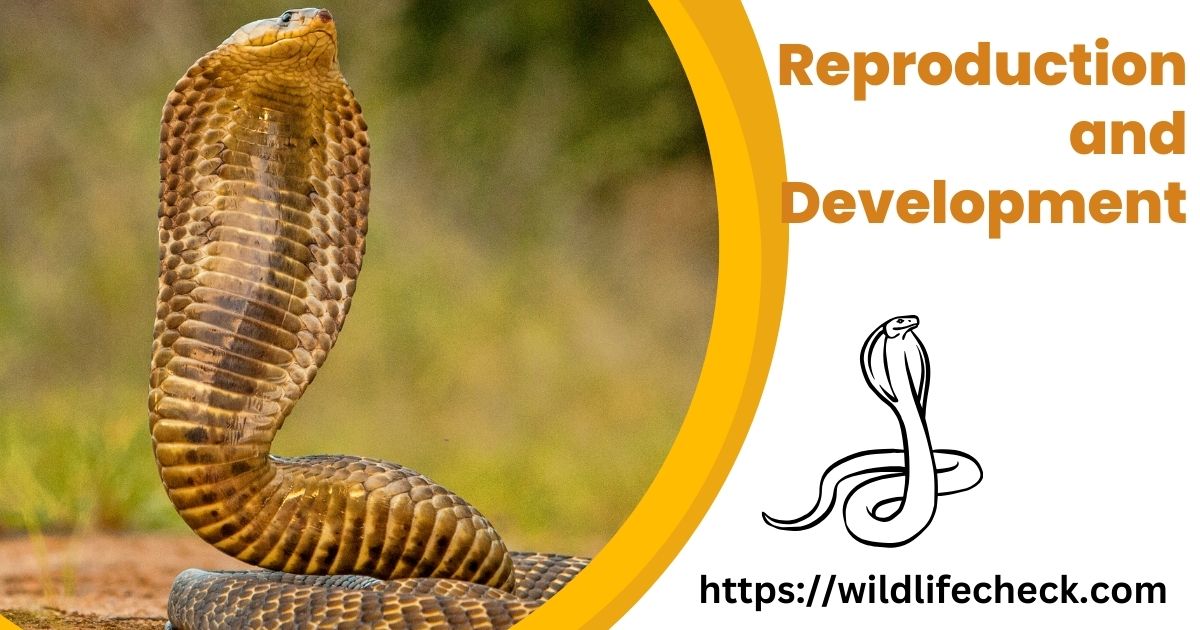
Sexual Maturity
Lord Cobras arrive at sexual development at around 3 to 4 years old, however this can differ contingent upon factors like size and natural circumstances. Guys ordinarily mature somewhat sooner than females.
During the rearing season, which ordinarily happens in the spring, guys participate in battle ceremonies to lay out predominance and secure mating freedoms with females. In the wake of mating, females will lay eggs, frequently making a home by curling around them to give security and control temperature during hatching.
Breeding Season
The reproducing season for Ruler Cobras regularly happens in the spring, despite the fact that it can change by locale. During this time, guys take part in battle showcases to lay out strength and draw in females.
In the wake of mating, females lay 20 to 40 eggs, which they safeguard by looping around them in a home until they hatch. This maternal way of behaving is moderately extraordinary among snakes. The brooding time frame typically goes on around 60 to 80 days, after which the youthful trapdoor and are free from the second they arise.
Breeding
Rearing in Ruler Cobras starts in the spring, when guys go after admittance to females through battle shows. In the wake of mating, females lay 20 to 40 eggs, which they cautiously watch by looping around them to keep up with temperature and safeguard against hunters.
The brooding time frame goes on around 60 to 80 days, after which the youthful trapdoor full fledged and are free from birth. Ruler Cobras don’t give further consideration in the wake of incubating, and the youthful should battle for themselves right away.
Incubation
The brooding time frame for Ruler Cobra eggs goes on around 60 to 80 days. During this time, the female curls around the eggs to give assurance and manage temperature. This maternal consideration is somewhat uncommon among snakes. When the eggs hatch, the youthful are full grown and free, expecting to find food and safe house quickly as they get no further consideration from the mother.
Cobra Snake Lays Eggs or Babies?
Cobra snakes, including Ruler Cobras, lay eggs. Most types of cobras are oviparous, meaning they recreate by laying eggs as opposed to bringing forth live youthful. The female regularly lays a grasp of eggs, which she then broods by winding around them until they hatch. The youthful snakes arise full fledged and are autonomous from birth.
Why do king cobras eat other cobras?
FAQ’S About Why do king cobras eat other cobras?
Why do King Cobras cannibalize other cobras?
Lord Cobras might tear up different cobras principally because of restricted food accessibility, permitting them to decrease contest and access a rich wellspring of protein.
Is cannibalism common among King Cobras?
While it’s not the essential taking care of conduct, savagery can happen, particularly during seasons of food shortage or expanded rivalry for assets.
Do King Cobras target specific types of cobras when eating them?
Indeed, they might like to eat more modest or more fragile people, including adolescent cobras or those that are harmed.
How does cannibalism affect King Cobra populations?
Human flesh consumption can assist with controlling populace thickness, diminish rivalry, and guarantee that more grounded people get by, possibly helping the general wellbeing of the populace.
What environmental factors increase cannibalism in King Cobras?
Factors like territory misfortune, diminished prey accessibility, and expanded rivalry can prompt higher occurrences of human flesh consumption among Ruler Cobras.
Are there any risks for King Cobras when eating other cobras?
Indeed, eating different cobras, particularly venomous species, can present dangers, yet Ruler Cobras have a resistance to the toxin of their own sort, permitting them to securely chase.
Can cannibalism affect the behavior of King Cobras?
Indeed, human flesh consumption can impact their regional and forceful ways of behaving, as rivalry for food can prompt more forceful experiences among people.
Conclusion¬
All in all, Ruler Cobras eat different cobrasessentially as a step by step process for surviving driven by variables like food accessibility, contest, and crafty taking care of conduct. Barbarianism permits them to lessen contest for assets and access a rich wellspring of supplements. While not a typical event, it can happen all the more habitually during seasons of shortage or natural pressure. This conduct assumes a part in keeping up with the general wellbeing and equilibrium of Ruler Cobra populaces, permitting more grounded people to flourish in their biological systems.

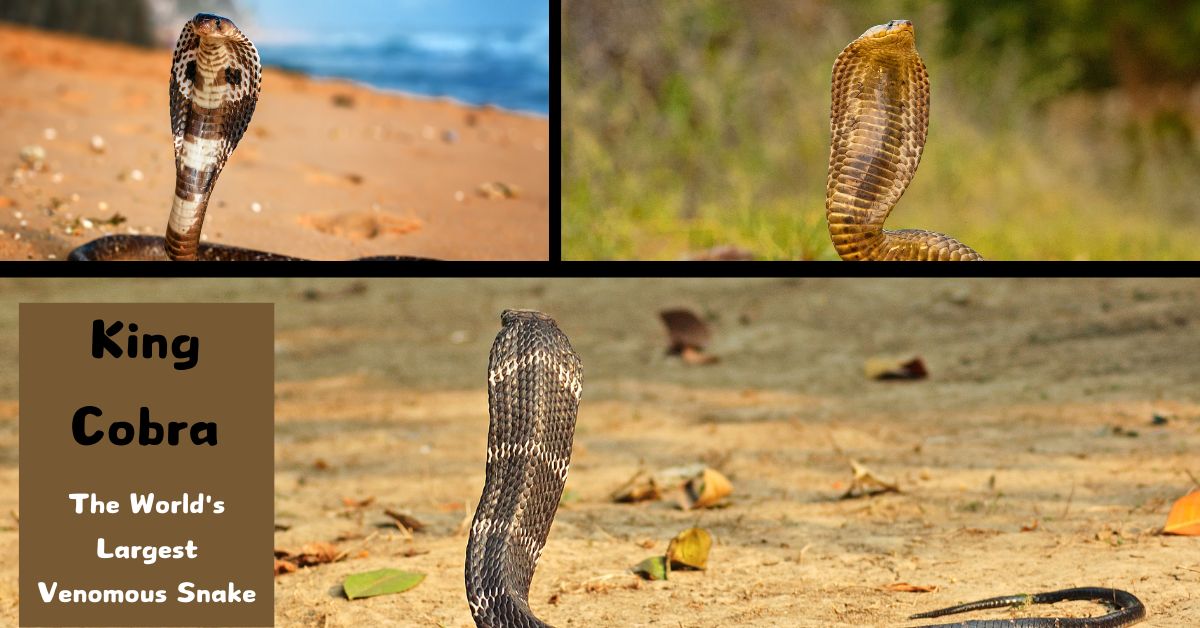
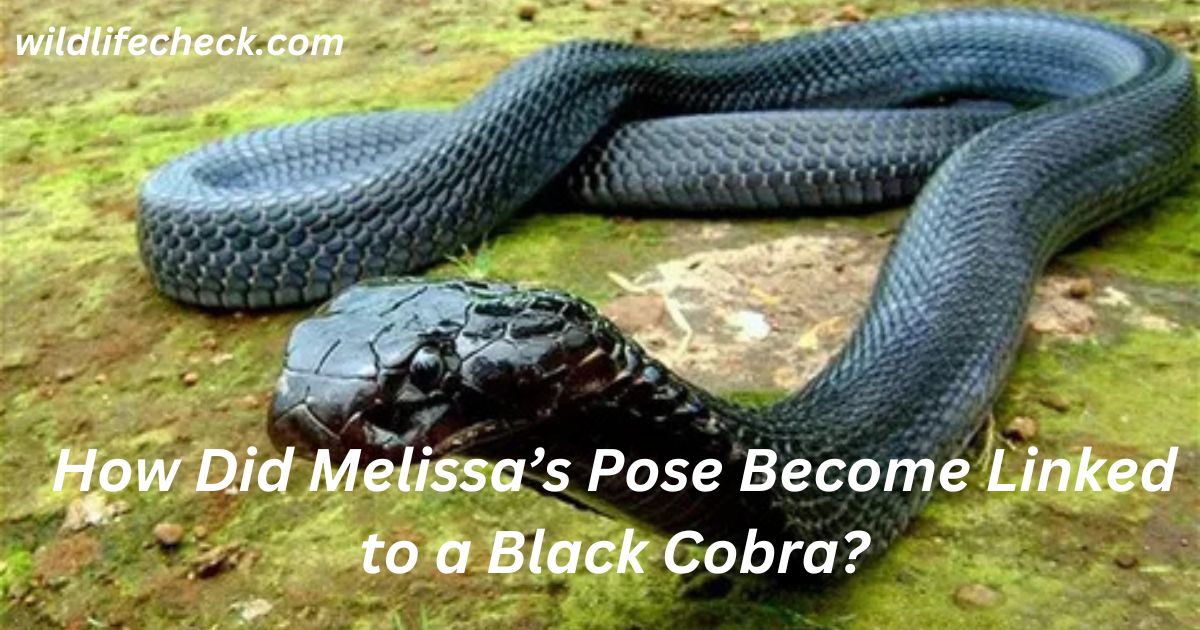
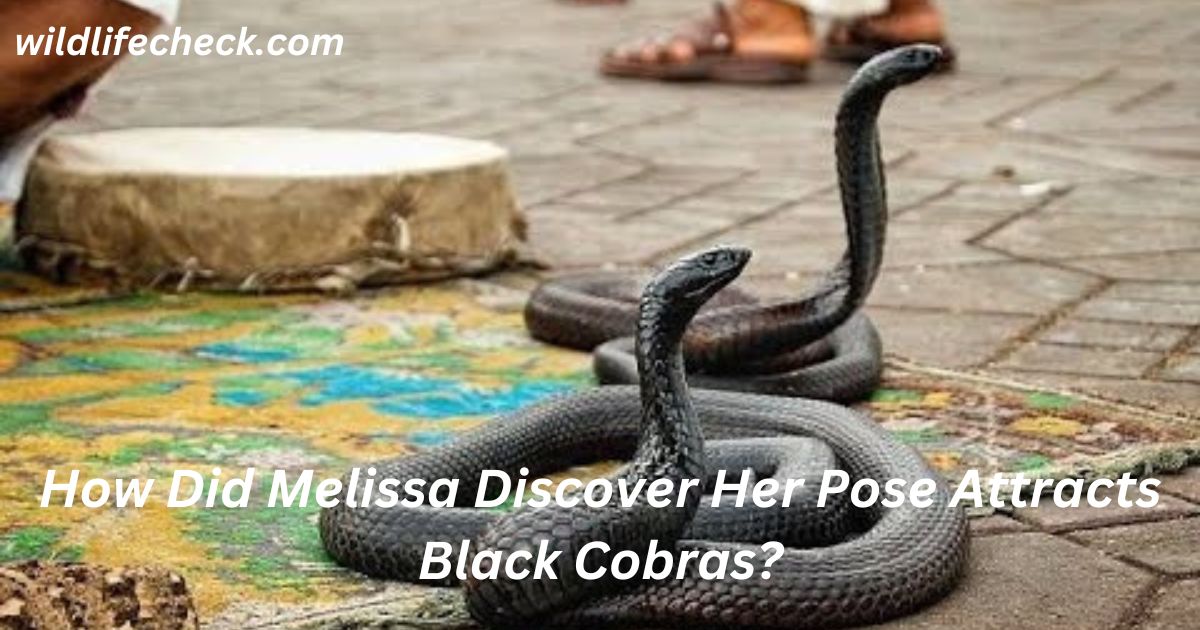

This is my first time pay a quick visit at here and i am really happy to read everthing at one place
This is really interesting, You’re a very skilled blogger. I’ve joined your feed and look forward to seeking more of your magnificent post. Also, I’ve shared your site in my social networks!
Thanks
Howdy, i read your blog occasionally and i own a similar one and i was just wondering if you get a lot of spam remarks? If so how do you protect against it, any plugin or anything you can advise? I get so much lately it’s driving me crazy so any assistance is very much appreciated.
I am continually browsing online for articles that can assist me. Thank you!